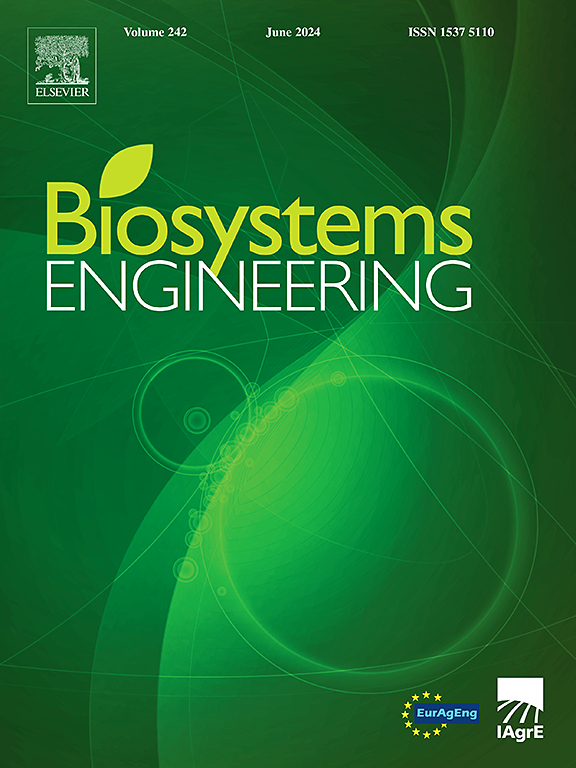Preliminary results of extensive tractor rollover stability tests using a tilting-rotating rig
IF 4.4
1区 农林科学
Q1 AGRICULTURAL ENGINEERING
引用次数: 0
Abstract
Addressing safety issues in mountain agro-forestry operations, a critical focus is on the stability of machines to prevent rollovers. Despite advancements in technologies and techniques enhancing overall safety, fatalities remain a significant concern. Italy, for instance, witnesses over 120 fatal accidents annually due to tractor rollovers. Even in less serious cases, they still lead to considerable vehicle damage and financial losses. Consequently, investigating and characterising the tractor stability behaviour emerges as a crucial endeavour. This has led to consider in this work, also for certification purposes, the definition of mixed approaches typical of twin models, with predictive modelling assessments extended to a broad application context complemented by punctual measurements on full-scale machines. These measurements have been carried out by means of a novel rotating and tilting test-rig for tractor rollover evaluation available at the Agroforestry Innovation Laboratory (AFILab) of the Free University of Bozen-Bolzano. The study concentrates in particular on examining and comparing the (static) rollover stability results on three different types of tractors commonly employed in mountain operations: a conventional tractor, a narrow track tractor, and a mountain-specialist model. The output of this approach are the stability maps, graphical tools summarising stability limit conditions for diverse configurations. The preliminary results, despite some simplifications adopted in the first version of the digital model, show an excellent correlation between the modelling approach and real measurements. Aspects for future refinement may concern the inclusion of procedures capable of reproducing tyre deformation with greater fidelity under conditions of significant slope.
利用倾斜旋转装置进行拖拉机侧翻稳定性试验的初步结果
解决山地农林业作业的安全问题,一个关键的重点是机器的稳定性,以防止翻滚。尽管技术和工艺的进步提高了总体安全性,但死亡人数仍然令人严重关切。例如,在意大利,每年因拖拉机翻车而导致的死亡事故超过120起。即使在不太严重的情况下,它们仍然会导致相当大的车辆损坏和经济损失。因此,研究和描述拖拉机的稳定性行为是一项至关重要的工作。这导致在这项工作中考虑,也是为了认证的目的,双模型的典型混合方法的定义,将预测建模评估扩展到广泛的应用环境,并辅以在全尺寸机器上的准时测量。这些测量是通过Bozen-Bolzano自由大学农林业创新实验室(AFILab)提供的用于拖拉机侧翻评估的新型旋转和倾斜试验台进行的。这项研究特别集中在检查和比较三种不同类型的拖拉机的(静态)侧翻稳定性结果,这些拖拉机通常用于山地作业:传统拖拉机、窄轨拖拉机和山地专家模型。这种方法的输出是稳定性图,总结了不同配置的稳定性极限条件的图形工具。初步结果表明,尽管在第一个版本的数字模型中采用了一些简化,但建模方法与实际测量结果之间具有良好的相关性。未来改进的方面可能涉及包含能够在显著坡度条件下以更高保真度再现轮胎变形的程序。
本文章由计算机程序翻译,如有差异,请以英文原文为准。
求助全文
约1分钟内获得全文
求助全文
来源期刊

Biosystems Engineering
农林科学-农业工程
CiteScore
10.60
自引率
7.80%
发文量
239
审稿时长
53 days
期刊介绍:
Biosystems Engineering publishes research in engineering and the physical sciences that represent advances in understanding or modelling of the performance of biological systems for sustainable developments in land use and the environment, agriculture and amenity, bioproduction processes and the food chain. The subject matter of the journal reflects the wide range and interdisciplinary nature of research in engineering for biological systems.
 求助内容:
求助内容: 应助结果提醒方式:
应助结果提醒方式:


